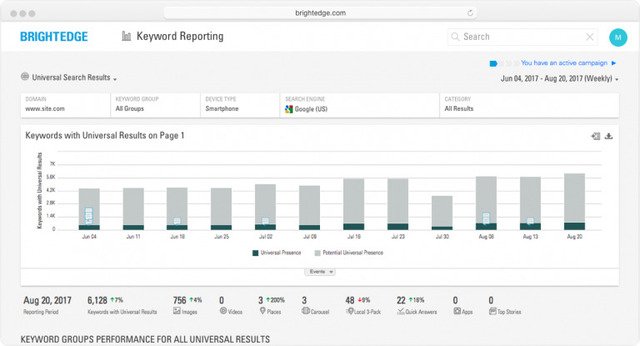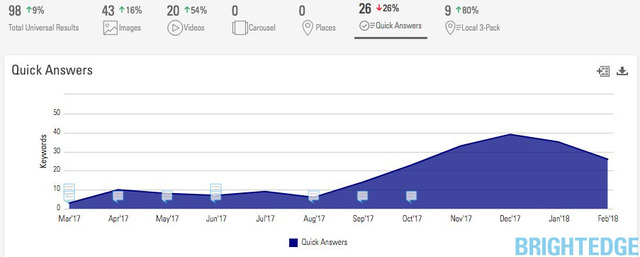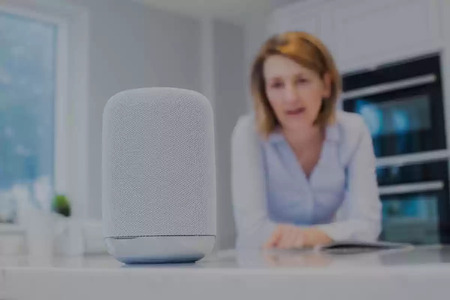Voice represents a significant transformation to the way end users interact with Search. The convergence of Voice, vertical search engines, and mobile will accelerate the fragmentation of Search and the need for agile and targeted SEO for voice.
Organic continues to be a critical channel for marketers. The expansion and modification of paid search placements on Google, implementation of the Knowledge Graph, featured snippets, local results, and now question-answer SERPs have all come and gone. Despite all of that we know that in 2017 Organic still comprised 51% of all web traffic on average. People continue to browse and engage with organic listings on the SERP. There is one technological development that seems to pose a fundamental shift to the way people interact with and navigate through search engines, and that's voice search. By speaking a query to your mobile or home device, the user effectively bypasses the SERP and is delivered an answer without ever having to browse search results, click through to a new site, or, in some cases, even look at a screen. This is the true "Position 0" reality that SEOs have been talking about for a while now. It's obvious that we need to start optimizing for voice, but there are extra levels of nuance beyond simply, "let's go after more Quick Answer boxes," that are worth considering.
Why is voice search important for digital marketing?
In one way, voice search results are simply a continued evolution of the featured snippets that now sit at the top of the SERP for a number of query-based search terms. Google itself has stated that featured snippets help with appearing in voice search queries, and Quick Answers featured snippets are often the source for the answers delivered by Google Voice Search and Google Home for voice queries. The significance of this relationship is even more apparent when you factor in that in 2016, Google SEO Sundar Pichai said a full 20% of Google searches made on mobile and Android devices are voice searches. The proliferation of voice search-enabled devices has also been dramatic. One in six adults in the United States owns a "smart speaker" device as of 2017, according to NPR and Edison Research. Additionally, a Northstar Research study commissioned by Google in 2014 found that 55% of teenagers and 41% of adults included in the survey used voice search more than once a day. It's for these reasons and more that we believe Voice will be a tidal wave that search marketers should be prepared to surf. Of course, the extent to which that's actionable depends partly on how much data is available to work off of, which is - at least for now - one of the main challenges.
What kind of voice search data do we have?
One of the biggest challenges SEOs and digital practitioners have in terms of optimizing for voice search is that we simply don't have very much tangible data on it yet. Back in 2016 John Mueller, Senior Webmaster Trends Analyst at Google, said in a Webmaster Central office hours session that Google had been in discussions to add voice search traffic data to Google Search Console. The amount of data that's been made available since then, however, has been limited. Mueller did subsequently mention that voice query data would likely be presented as a separate dataset from standard GSC keyword data, but not much else. This isn't out of any desire to withhold information on the part of Google. Rather, as Mueller himself has said, the challenge on the search engine side has been to figure out the optimal way to parse and display this huge new dataset in a way that will be intelligible to the marketer. Despite this, based on best practices for featured snippets and aforementioned Quick Answers we do know enough to have a good sense of how to position for Voice:
yet. Back in 2016 John Mueller, Senior Webmaster Trends Analyst at Google, said in a Webmaster Central office hours session that Google had been in discussions to add voice search traffic data to Google Search Console. The amount of data that's been made available since then, however, has been limited. Mueller did subsequently mention that voice query data would likely be presented as a separate dataset from standard GSC keyword data, but not much else. This isn't out of any desire to withhold information on the part of Google. Rather, as Mueller himself has said, the challenge on the search engine side has been to figure out the optimal way to parse and display this huge new dataset in a way that will be intelligible to the marketer. Despite this, based on best practices for featured snippets and aforementioned Quick Answers we do know enough to have a good sense of how to position for Voice:
- Analyze your search reporting for question queries and long queries
- Find the 100 most popular questions in your industry, site, CS, or, help section
- Ask the question in the title, answer the question in the body
- Focus on answers and getting position 1 and Quick Answers or “position 0”
- Check for popular answers in Yahoo Answers and Quora
- Enhance use of structured micro-data and schema
- Enable voice-to-text to search your site to match context query was made in
- Use conversational language on pages to map to queries coming from digital assistants
BrightEdge can help you to better identify and target these Quick Answer and featured snippet and, by extension, voice search opportunities. By using the Universal Search Results view in the Keyword Reporting module, as well as looking up your own domain in Data Cube, you can track which Quick Answer boxes you already possess as well as SERPs where you do show up, but don't have Quick Answer placement. Additionally, the Insights solution can elevate Quick Answers opportunities to you based on your existing list of tracked keywords. There is also a whole other additional layer of abstraction (and potential for growth) in SEO for voice: The ever-growing universe of vertical search engines.
Additionally, the Insights solution can elevate Quick Answers opportunities to you based on your existing list of tracked keywords. There is also a whole other additional layer of abstraction (and potential for growth) in SEO for voice: The ever-growing universe of vertical search engines.
Voice search and vertical search engines
There's a layer of complexity to voice search that's easy to miss, and that's that Voice is fragmented. There are two separate points of fragmentation worth pointing out: Firstly, there's a whole universe of other search engines out there. Major examples include Amazon, Facebook, LinkedIn, and YouTube. Depending on your industry and business model, many of these vertical search engines can be of significant value. The need for SEOs to start thinking about vertical search engines is something we've talked about before, but the rise of Voice makes it all the more important. Secondly, when we talk about Voice as a whole we often use the term to refer just to voice searches conducted on Google, and we don't factor in device type. Devices, however, are a vital aspect of how voice search will be delivered to and conducted by end users. Consider how it was only around September of 2017 when Apple switched the default search engine of Siri, the voice-activated digital assistant of iOS, from Bing to Google. Compare this to the Amazon Echo, which uses Bing. There are also narrower, but just as powerful examples, such as how Bixby, Samsung's virtual assistant for Galaxy devices, offers a visual search feature, which can identify brands and products and direct the user to ecommerce listings, uses Pinterest's Lens tool. While these individual examples may not be relevant to every search marketer, they are indicative of how the confluence of Voice, mobile device proliferation, and vertical search engines can drastically affect the angles of attack in SEO for voice search. Observe this example of a mundane voice search query using Alexa that delivers results solely for Amazon-branded products.
Different vertical search engines equal different search intent
Not all search engines are created equally. There are many potential scenarios where a brand may be better served focusing its SEO efforts on one search engine or a set of search engines versus another. It's clear that Voice is transforming organic search as we know it. This transformation isn't the end of Organic, it's another layer of complexity that will make savvy SEOs and digital marketers who understand user intent and approach it using a smart content framework more important than ever. If you're hoping to gain more information on the topic, download BrightEdge's POV on voice search.

